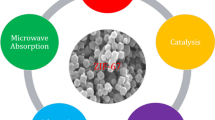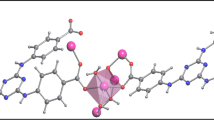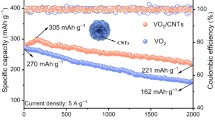Physicochemical methods are used to study the electronic state of cobalt cations in nanostructures produced by thermal decomposition of salts on the surface and in the bulk of ZSM-5, Al2O3, SiO2, and ERI matrices. It is shown that the electronic state of cobalt is influenced by the type of matrix and cobalt–adsorbed oxygen ratio. It is established that cobalt cations can be immobilized in the tetrahedral and octahedral oxygen environment of the matrix and the oxidation state can change (Co2+ → Co3+) because of the transition from tetrahedral to octahedral coordination.






Similar content being viewed by others
References
M. S. Slobodyanik and O. M. Zaslavskii, “Structural transformations of cerium and praseodymium oxides in vacuum condensates,” Dop. NAN Ukrainy, No. 11, 149–154 (2009).
N. R. E. Radwan, G. A. Fagal, and G. A. El-Shobaky, “Effects of CeO2-doping on surface and catalytic properties of CuO/Al2O3 solids,” Coll. Surf. A: Physicochem. Eng. Aspects, 178, No. 1–3, 277–286 (2001).
R. Craciun, B. Nentwick, K. Hadjiivanov, and H. Knozinger, “Structure and redox properties of MnO x /yttrium-stabilized zirconia (YSZ) catalyst and its use in CO and CH4 oxidation,” Appl. Catal. A Gen., 243, 67–79 (2003).
V. K. Yatsimirskii, L. P. Oleksenko, and L. V. Lutsenko, “Influence of the type of support and formation conditions of Co-containing catalysts on their activity in the oxidation reaction of CO,” Ukr. Kkim. Zh., 69, No. 8, 94–99 (2003).
L. P. Oleksenko, O. M. Zaslavskii, and M. S. Slobodyanik, “Influence of the type of support on the oxidation state of cobalt and the structure of its oxygen-containing phases in supported catalysts,” Dop. NAN Ukrainy, No. 7, 149–154 (2010).
G. Brauer, Handbook of Preparative Inorganic Chemistry, Vol. 2, Academic Press, New York (1965).
V. I. Nefedov, X-ray Photoelectron Spectroscopy of Chemical Compounds [in Russian], Khimiya, Moscow (1984), pp. 9–28.
L. P. Oleksenko, V. K. Yatsimirsky, G. M. Telbiz, and L. V. Lutsenko, “Adsorption and catalytic properties of Co/ZSM-5 zeolite catalysts for CO oxidation,” Adsorpt. Sci. Technol., 22, No. 7, 535–541 (2004).
J. A. Rabo (ed.), Zeolite Chemistry and Catalysis, American Chemical Society, Washington (1976).
L. P. Oleksenko, “Formation of active centers of Co-containing CO-oxidation catalysts on supports of different chemical nature,” Teor. Éksp. Khim., 40, No. 5, 316–321 (2004).
V. V. Nemoshkalenko and V. G. Aleshin, Electron Spectroscopy of Crystals, Plenum Press, New York (1979).
A. B. P. Lever, Inorganic Electronic Spectroscopy, Elsevier, New York (1984).
Author information
Authors and Affiliations
Corresponding author
Additional information
Translated from Poroshkovaya Metallurgiya, Vol. 51, No. 7–8 (486), pp. 20–29, 2012.
Rights and permissions
About this article
Cite this article
Olekseenko, L.P., Zaslavskii, A.M. & Slobodyanik, N.S. Effect of the type of matrix on the electronic state of cobalt cations in impregnated catalytically active nanostructures. Powder Metall Met Ceram 51, 391–398 (2012). https://doi.org/10.1007/s11106-012-9447-9
Received:
Published:
Issue Date:
DOI: https://doi.org/10.1007/s11106-012-9447-9




